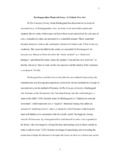Please use this identifier to cite or link to this item:
https://elibrary.tucl.edu.np/handle/123456789/678| Title: | Irony in Updike’s Rabbit, Run: A Kierkegaardain Reading |
| Authors: | Sapkota, Kamal Prasad |
| Keywords: | sexuality;Christianity;faith;immorality |
| Issue Date: | Feb-2011 |
| Publisher: | Central Department of English |
| Institute Name: | Central Department of English |
| Level: | Masters |
| Abstract: | John Updike’s Rabbit, Run exemplifies Kierkegaardian mastered irony. As an exemplar of this type of irony, the novel presents the two sides of issue and then leaves this paradox unresolved so that the intended meaning emerges as a play of contradiction. Updike organizes the moral debates about Christianity and evokes the ambiguity about sexuality and Christianity, paradox of God, faith, immorality and value of goodness. Kierkegaardian dialectical vision of mastered irony contains and maintains a species of controlled dialectical tension between the contradictory materials. The message of any ironic work is not represented by one or the other side of the dialectical issues; nor it is produced by the facial blending of the two; rather it comes out from the dynamic interplay of the unresolved thematic tension. Adopting this method, Updike dramatizes a dynamic play between the thematic tension raised in the novel that he calls the yes-but quality of his writing. All of the Rabbit's aesthetic yes has its own ethical but. Yes side of Rabbit's innerfreedom enables him to run and his social identity says but. Rabbit's search for something ultimately ends in nothing. Being a Christian minister, Eccles does not believe in anything. He represents the restrictive religio-socio sides of life. Such yes-but provides a paradoxical quality in the novel and all the conflicts and ambiguities are left unresolved. |
| URI: | http://elibrary.tucl.edu.np/handle/123456789/678 |
| Appears in Collections: | English |
Files in This Item:
| File | Description | Size | Format | |
|---|---|---|---|---|
| cover.pdf | 47.05 kB | Adobe PDF |  View/Open | |
| chapter.pdf | 199.14 kB | Adobe PDF |  View/Open |
Items in DSpace are protected by copyright, with all rights reserved, unless otherwise indicated.
